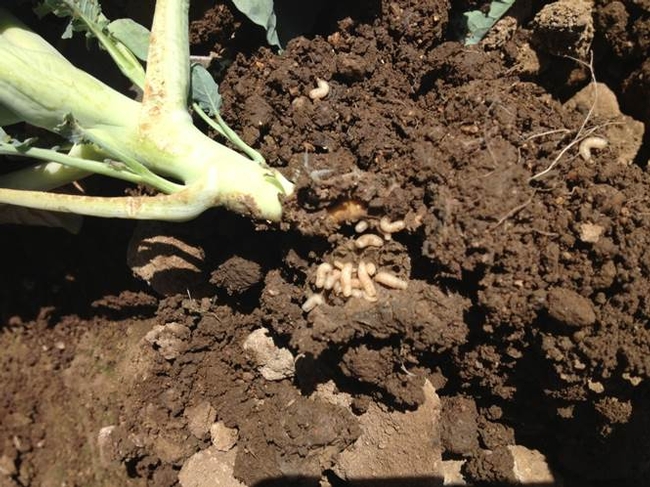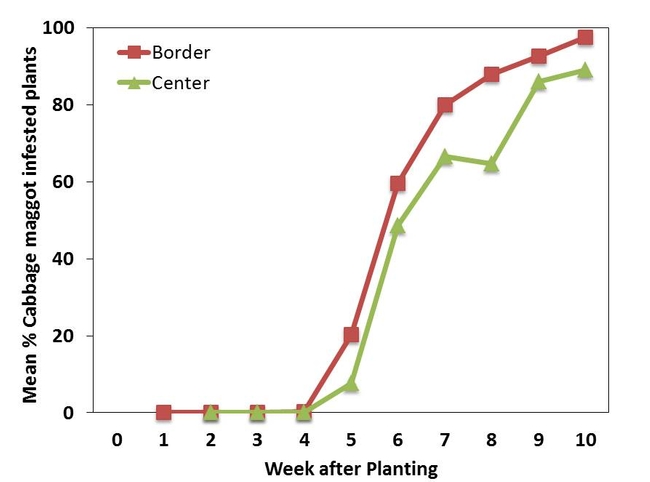Cabbage maggot (Delia radicum) is one of the most destructive pests of cruciferous crops in the Salinas Valley. Cabbage maggot flies lay eggs in the soil around the base of the plant. A single female can lay about 300 eggs under laboratory conditions. Legless,8-mm long white-maggots feed on the taproot and affect normal plant development. After about 3 weeks of feeding, the maggot pupates in the surrounding soil and remains at this stage for 2-4 weeks before emerging into an adult fly. The most common above-ground feeding symptoms of cabbage maggot are yellowing, stunting and slow growth.
Because the winter weather in the Salinas Valley is mild and rarely goes below freezing point, not all cabbage maggot pupae go into a resting stage, often called as diapause. This means our unique environment enables cabbage maggot flies to remain active even in winter months, producing multiple overlapping generations throughout the year. In this post organophosphate era with stringent restrictions for chlorpyrifos and diazinon use and less persistent insecticides being available for cabbage maggot management, knowledge of field-level incidence of cabbage maggot infestation is critical to determine precise timing for insecticide applications in brassicas. We studied the temporal incidence of cabbage maggot relative to seeded broccoli and turnip in the Salinas Valley.
Cage studies showed that severe injury from cabbage maggot did not appear during the first 14 days after plant emergence but was greater during 15-28 days after plant emergence. Similarly, survey in broccoli fields indicates that cabbage maggot flies did not lay a high number of eggs at the base of the plant until three weeks after plant emergence, despite presence of adult cabbage maggot in the field during the early stages of plant development (Figures below). On turnip, notable injury from cabbage maggot did not appear until five weeks after plant emergence. This is important information because typically insecticides targeting cabbage maggot were applied mostly at planting. Researchers showed that cabbage maggot infestation could be suppressed by using organophosphate insecticides, particularly chlorpyrifos, for more than a month after planting because product residues persisted for an extended period. However, most of us are not using these insecticides and a consistent cabbage maggot control using organophosphate insecticides was never attained in the Salinas Valley. I'm working on insecticides to determine their effectiveness against cabbage maggot and will share that information as soon as it is available.
It is unclear why increased cabbage maggot oviposition did not occur during the early stages of plant development. It is possible that the invading cabbage maggot flies cannot distinguish the young seedlings at a certain size relative to the surrounding area of bare soil. Cabbage maggot populations and crop injury from this pest tend to be more abundant in the border than the interior zone of the field; this invasion pattern continues throughout the growing period. In conclusion, our data suggest that the important season periods in the central coast vegetable production area to consider targeting cabbage maggot control are three to four weeks after planting the seeds. I will continue to monitor if other maggot species (seedcorn maggot or onion maggot) which could attack when brassica plants are at younger stages especially during spring or early summer.
For those of you, who are interested to read more on it, please find the published article after clicking the link (below) and feel free to contact me (Shimat Joseph) at svjoseph@ucanr.edu or 831 759 7359.


